Retinal Microvasculature in Systemic Sclerosis Patients and the Correlation between Nailfold Capillaroscopic Findings and Optical Coherence Angiography Results
Abstract
1. Introduction
2. Materials and Methods
Statistical Analysis
3. Results
4. Discussion
5. Conclusions
Author Contributions
Funding
Institutional Review Board Statement
Informed Consent Statement
Data Availability Statement
Conflicts of Interest
References
- Gomes, B.d.A.; Santhiago, M.R.; Magalhães, P.; Kara-Junior, N.; Azevedo, M.N.; Moraes, H.V., Jr. Ocular findings in patients with systemic sclerosis. Clinics 2011, 66, 379–385. [Google Scholar] [CrossRef]
- Lear, T.B.; Lockwood, K.C.; Larsen, M.; Tuncer, F.; Kennerdell, J.R.; Morse, C.; Valenzi, E.; Tabib, T.; Jurczak, M.J.; Kass, D.J.; et al. Kelch-like protein 42 is a profibrotic ubiquitin E3 ligase involved in systemic sclerosis. J. Biol. Chem. 2020, 295, 4171–4180. [Google Scholar] [CrossRef]
- Nikpour, M.; Stevens, W.M.; Herrick, A.L.; Proudman, S.M. Epidemiology of systemic sclerosis. Best Pract. Res. Clin. Rheumatol. 2010, 24, 857–869. [Google Scholar] [CrossRef] [PubMed]
- Krasowska, D.; Rudnicka, L.; Dańczak-Pazdrowska, A.; Chodorowska, G.; Woźniacka, A.; Lis-Święty, A.; Czuwara, J.; Maj, J.; Majewski, S.; Sysa-Jędrzejowska, A.; et al. Systemic sclerosis—Diagnostic and therapeutic recommendations of the Polish Dermatological Society. Part 1: Diagnosis and monitoring. Dermatol. Rev./Przegl. Dermatol. 2017, 104, 483–498. [Google Scholar] [CrossRef]
- Saygin, D.; Highland, K.B.; Tonelli, A.R. Microvascular involvement in systemic sclerosis and systemic lupus erythematosus. Microcirculation 2019, 26, e12440. [Google Scholar] [CrossRef]
- Pawlik, K.; Bohdziewicz, A.; Maciejewska, M.; Prado, J.; Czuwara, J.; Olszewska, M.; Rudnicka, L. Evaluation of cutaneous microcirculation in systemic sclerosis. An update. Dermatol. Rev. 2023, 110, 499–517. [Google Scholar] [CrossRef]
- Lambova, S.N.; Müller-Ladner, U. Nailfold capillaroscopy in systemic sclerosis—State of the art: The evolving knowledge about capillaroscopic abnormalities in systemic sclerosis. J. Scleroderma Relat. Disord. 2019, 4, 200–211. [Google Scholar] [CrossRef]
- Smith, V.; Herrick, A.L.; Ingegnoli, F.; Damjanov, N.; De Angelis, R.; Denton, C.P.; Distler, O.; Espejo, K.; Foeldvari, I.; Frech, T.; et al. Standardisation of nailfold capillaroscopy for the assessment of patients with Raynaud’s phenomenon and systemic sclerosis. Autoimmun. Rev. 2020, 19, 102458. [Google Scholar] [CrossRef] [PubMed]
- Cutolo, M.; Sulli, A.; Pizzorni, C.; Accardo, S. Nailfold videocapillaroscopy assessment of microvascular damage in systemic sclerosis. J. Rheumatol. 2000, 27, 155–160. [Google Scholar]
- Jia, Y.; Tan, O.; Tokayer, J.; Potsaid, B.; Wang, Y.; Liu, J.J.; Kraus, M.F.; Subhash, H.; Fujimoto, J.G.; Hornegger, J.; et al. Split-spectrum amplitude-decorrelation angiography with optical coherence tomography. Opt. Express 2012, 20, 4710–4725. [Google Scholar] [CrossRef]
- Paczwa, K.; Gołębiewska, J. Optical Coherence Tomography and Optical Coherence Tomography Angiography in Ophthalmology. Pol. J. Aviat. Med. Bioeng. Psychol. 2020, 26, 45–54. [Google Scholar] [CrossRef]
- de A., F.; Gomes, B.; Santhiago, M.R.; de Azevedo, M.N.L.; Moraes, H.V., Jr. Evaluation of dry eye signs and symptoms in patients with systemic sclerosis. Graefe’s Arch. Clin. Exp. Ophthalmol. 2012, 250, 1051–1056. [Google Scholar] [CrossRef] [PubMed]
- Sahin Atik, S.; Koc, F.; Akin Sari, S.; Sefi Yurdakul, N.; Ozmen, M.; Akar, S. Anterior segment parameters and eyelids in systemic sclerosis. Int. Ophthalmol. 2016, 36, 577–583. [Google Scholar] [CrossRef] [PubMed]
- Kozikowska, M.; Luboń, W.; Kucharz, E.; Mrukwa-Kominek, E. Ocular manifestations in patients with systemic sclerosis. Reumatologia 2020, 58, 401–406. [Google Scholar] [CrossRef] [PubMed]
- Tailor, R.; Gupta, A.; Herrick, A.; Kwartz, J. Ocular manifestations of scleroderma. Surv. Ophthalmol. 2009, 54, 292–304. [Google Scholar] [CrossRef] [PubMed]
- Szucs, G.; Szekanecz, Z.; Aszalos, Z.; Gesztelyi, R.; Zsuga, J.; Szodoray, P.; Kemeny-Beke, A. A Wide Spectrum of Ocular Manifestations Signify Patients with Systemic Sclerosis. Ocul. Immunol. Inflamm. 2021, 29, 81–89. [Google Scholar] [CrossRef]
- Cutolo, M.; Pizzorni, C.; Secchi, M.E.; Sulli, A. Capillaroscopy. Best Pract. Res. Clin. Rheumatol. 2008, 22, 1093–1108. [Google Scholar] [CrossRef] [PubMed]
- Asano, Y. Systemic sclerosis. J. Dermatol. 2018, 45, 128–138. [Google Scholar] [CrossRef] [PubMed]
- Ushiyama, O.; Ushiyama, K.; Yamada, T.; Koarada, S.; Tada, Y.; Suzuki, N.; Ohta, A.; Nagasawa, K. Retinal findings in systemic sclerosis: A comparison with nailfold capillaroscopic patterns. Ann. Rheum. Dis. 2003, 62, 204–207. [Google Scholar] [CrossRef]
- Kök, M.; Ayan, A.; Fatih Küçük, M.; Erol, M.K.; Yaprak, L. Evaluation of the direct effects on retinal and choroidal microvascularity of systemic scleroderma. Microvasc. Res. 2021, 136, 104166. [Google Scholar] [CrossRef]
- Kılınç Hekimsoy, H.; Şekeroğlu, M.A.; Koçer, A.M.; Akdoğan, A. Analysis of retinal and choroidal microvasculature in systemic sclerosis: An optical coherence tomography angiography study. Eye 2020, 34, 763–770. [Google Scholar] [CrossRef] [PubMed]
- Mihailovic, N.; Lahme, L.; Braasch, S.; Rosenberger, F.; Eter, N.; Ehrchen, J.; Alnawaiseh, M. Altered ocular microvasculature in patients with systemic sclerosis and very early disease of systemic sclerosis using optical coherence tomography angiography. Sci. Rep. 2022, 12, 10990. [Google Scholar] [CrossRef] [PubMed]
- Cutolo, C.A.; Cere, A.; Toma, P.; Cannavacciuolo, T.; Toma, C.; Balito, S.; Gerli, V.; Smith, V.; Sulli, A.; Paolino, S.; et al. Peripheral and ocular microvascular alterations in systemic sclerosis: Observations from capillaroscopic assessments, perfusion peripheral analysis, and optical coherence tomography angiography. Rheumatol. Int. 2024, 44, 107–118. [Google Scholar] [CrossRef] [PubMed]
- Manetti, M.; Guiducci, S.; Ibba-Manneschi, L.; Matucci-Cerinic, M. Mechanisms in the loss of capillaries in systemic sclerosis: Angiogenesis versus vasculogenesis. J. Cell. Mol. Med. 2010, 14, 1241–1254. [Google Scholar] [CrossRef] [PubMed]
- Carnevali, A.; Giannaccare, G.; Gatti, V.; Battaglia, C.; Randazzo, G.; Yu, A.C.; Pellegrini, M.; Ferragina, F.; Toro, M.D.; Bruno, C.; et al. Retinal microcirculation abnormalities in patients with systemic sclerosis: An explorative optical coherence tomography angiography study. Rheumatology 2021, 60, 5827–5832. [Google Scholar] [CrossRef] [PubMed]
- Rothe, M.; Rommel, F.; Klapa, S.; Humrich, J.Y.; Nieberding, R.; Lange, T.; Sochurek, J.A.M.; Plöttner, P.; Grisanti, S.; Riemekasten, G.; et al. Evaluation of retinal microvascular perfusion in systemic sclerosis: A case–control study. Ann. Rheum. Dis. 2019, 78, 857–858. [Google Scholar] [CrossRef] [PubMed]
- Wielgosz, E. The usefulness of capillaroscopy for assessment of microcirculation disturbances during treatment. Forum Reumatol. 2019, 5, 65–69. [Google Scholar] [CrossRef][Green Version]
- Lemmers, J.M.J.; Velauthapillai, A.; van Herwaarden, N.; Vonk, M.C. Change of the microvascularization in systemic sclerosis, a matter of air. Best Pract. Res. Clin. Rheumatol. 2021, 35, 101683. [Google Scholar] [CrossRef]
- Polak, K.; Wimpissinger, B.; Berisha, F.; Georgopoulos, M.; Schmetterer, L. Effects of Sildenafil on Retinal Blood Flow and Flicker-Induced Retinal Vasodilatation in Healthy Subjects. Investig. Ophthalmol. Vis. Sci. 2003, 44, 4872–4876. [Google Scholar] [CrossRef]

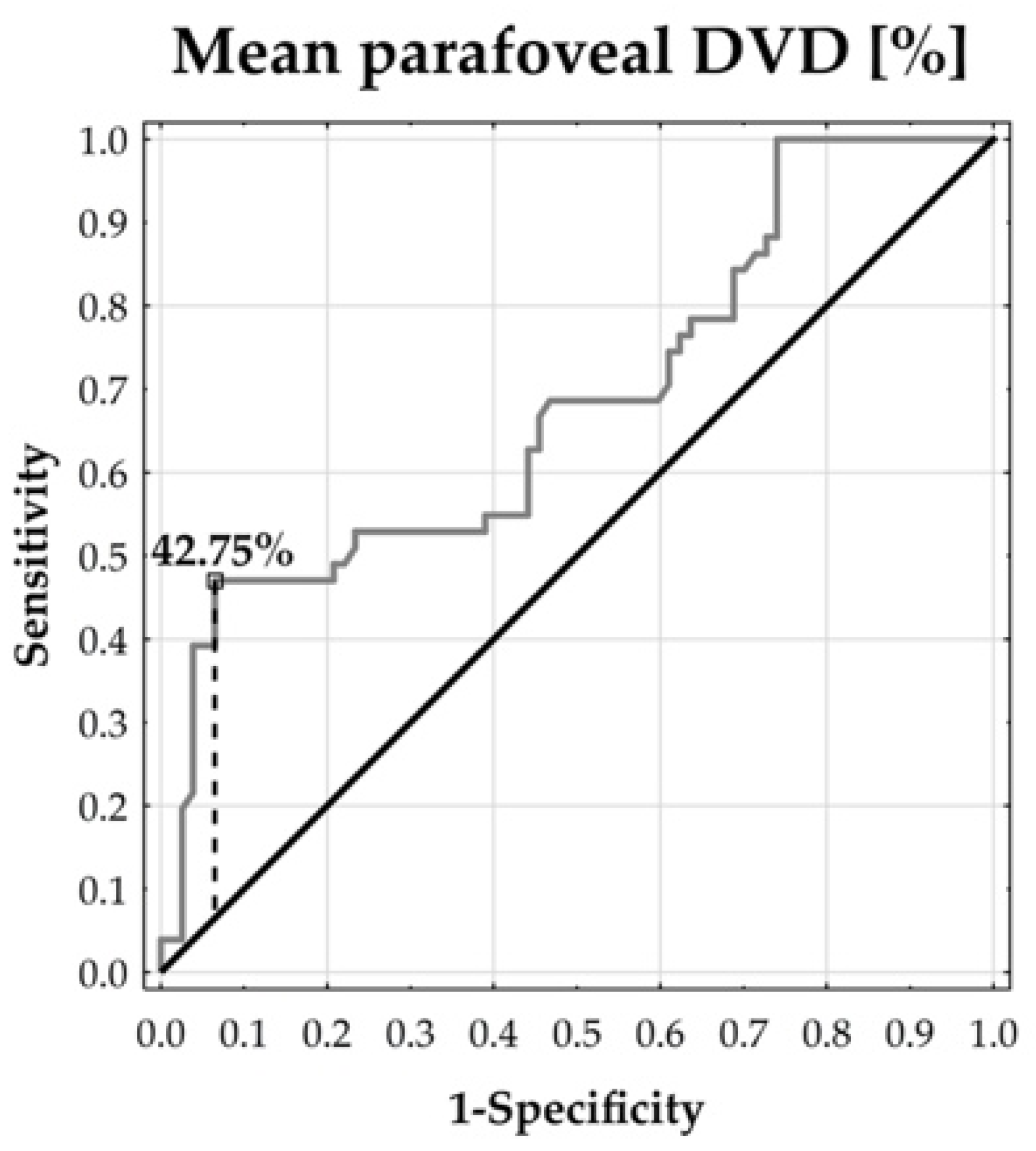
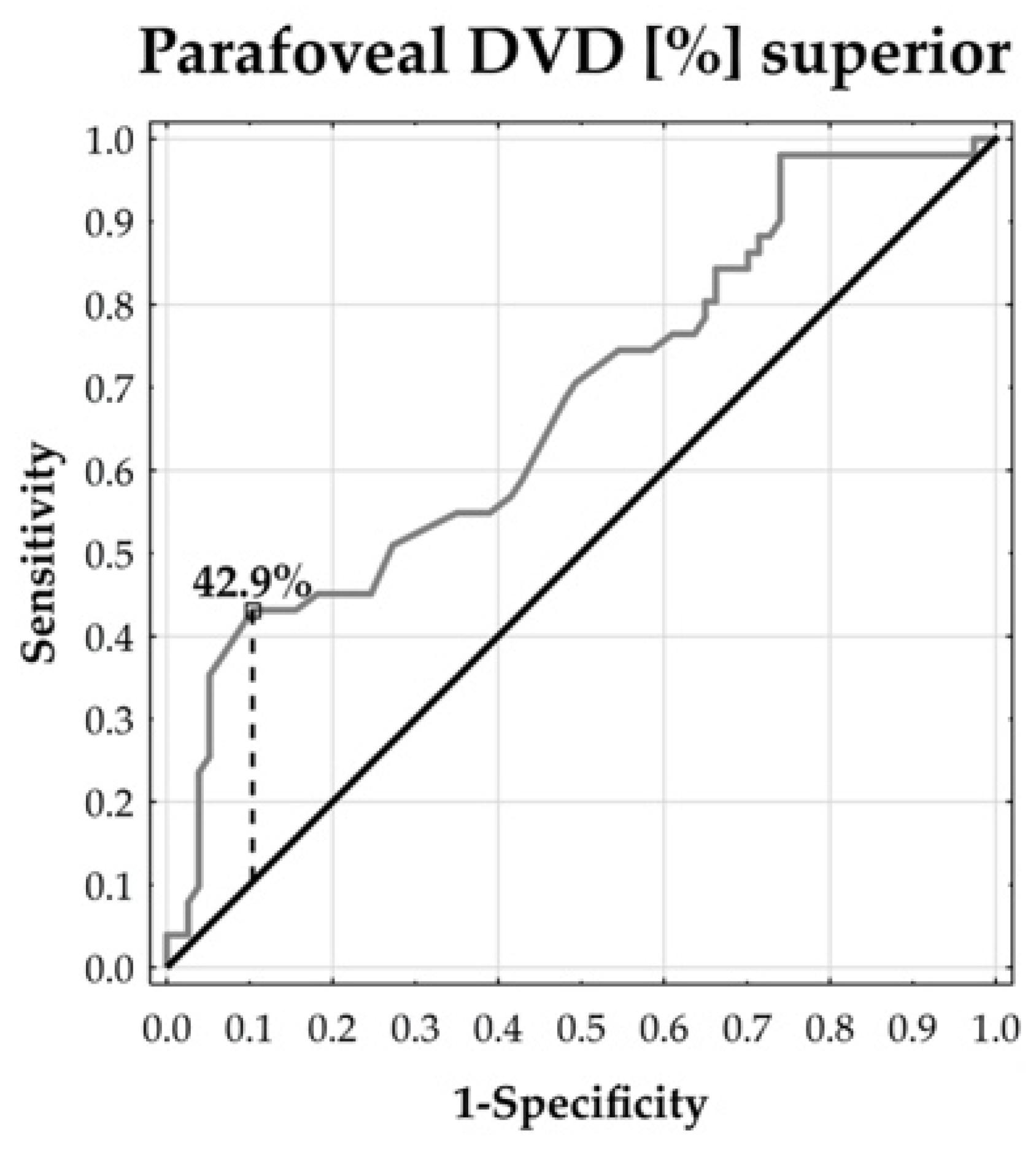
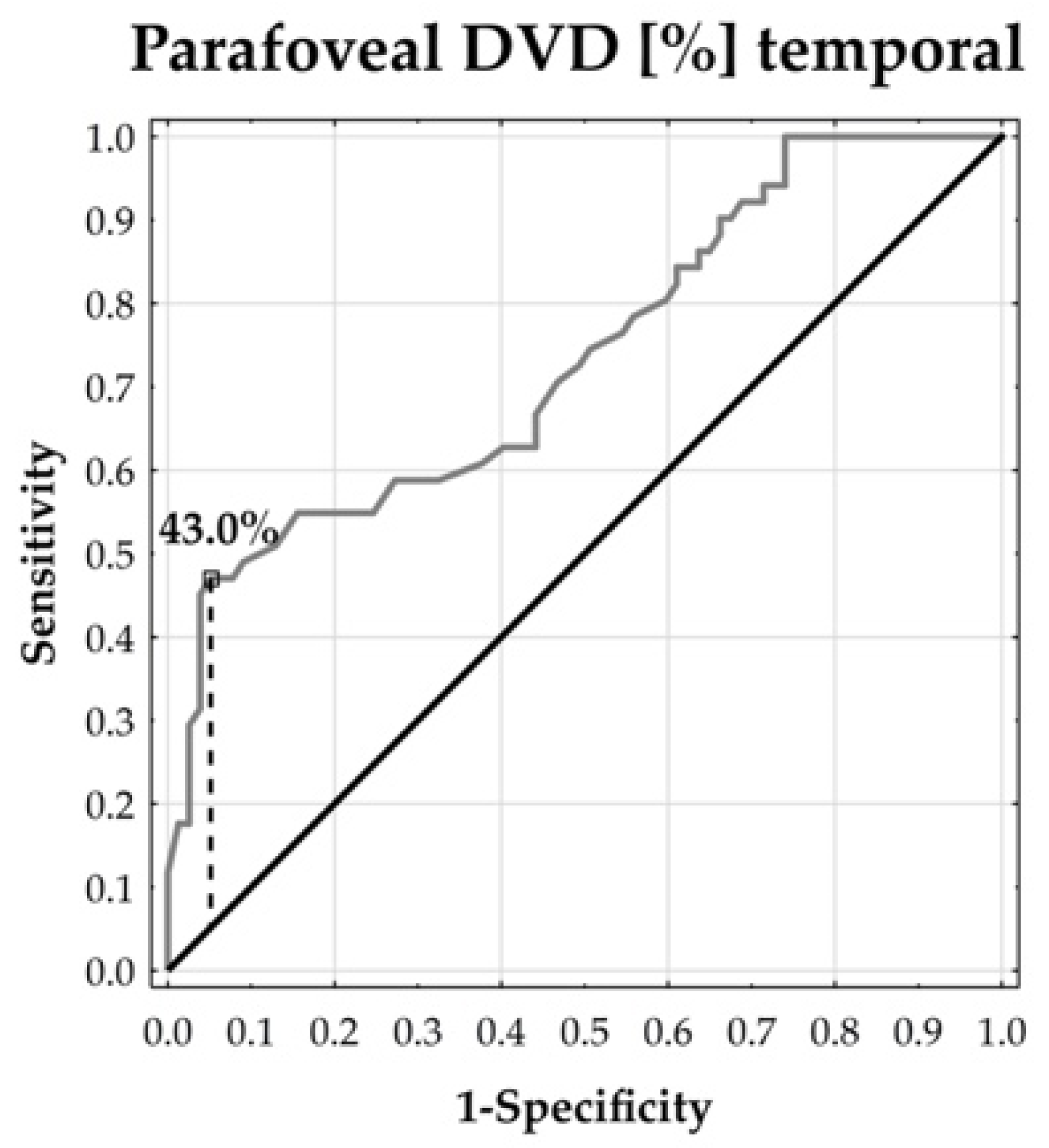
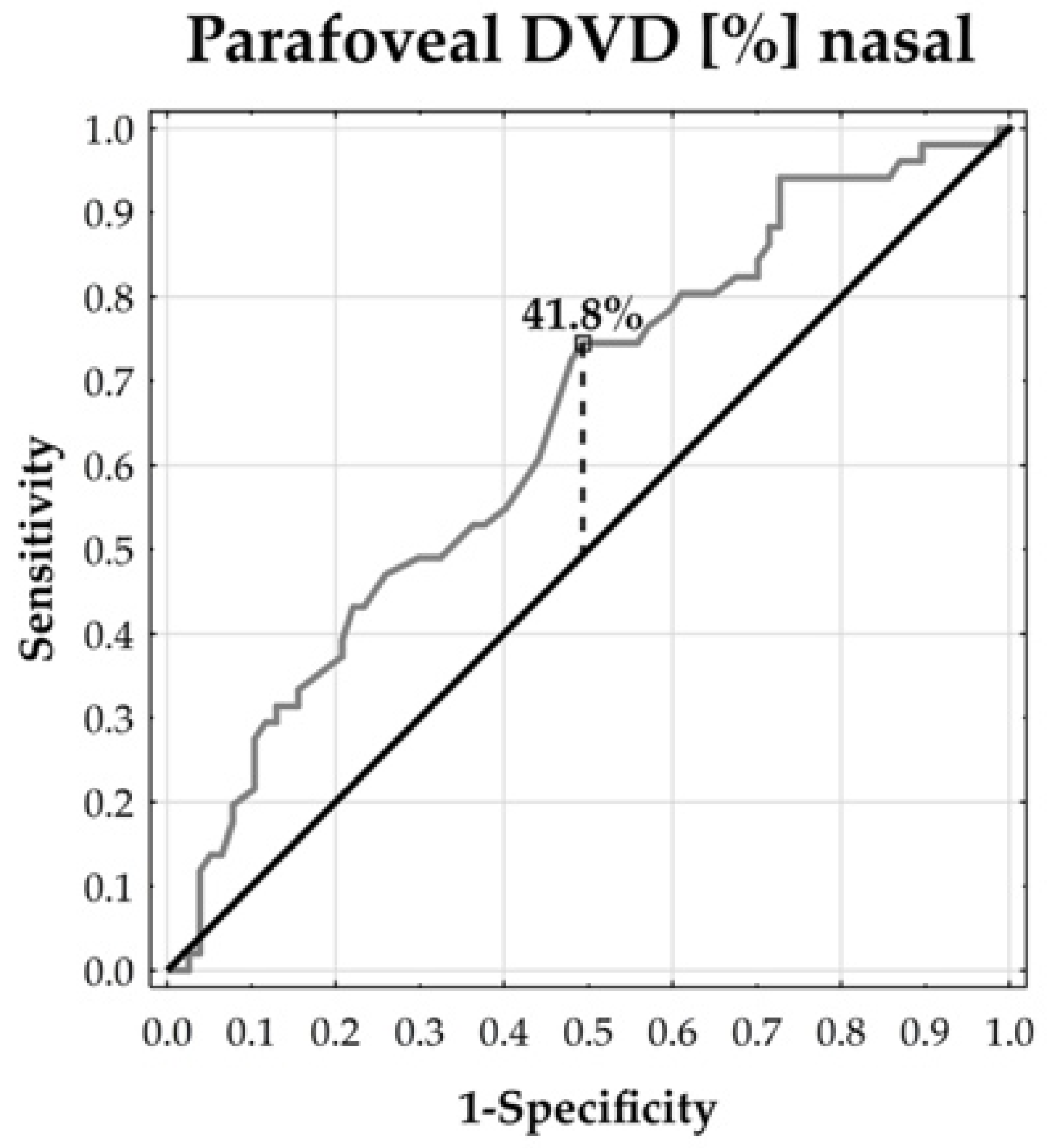
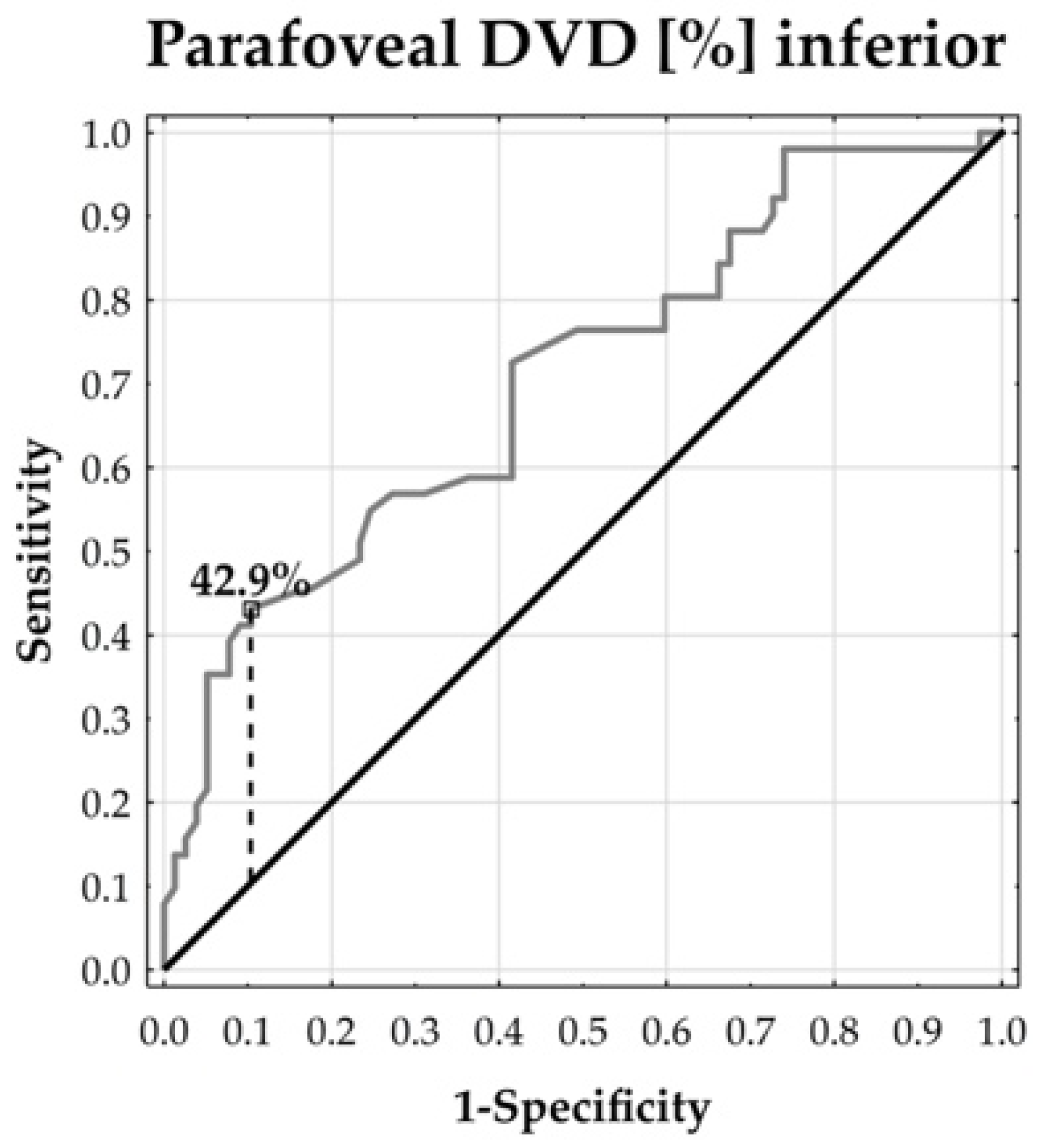
| Trait | n M (SD) * | % Me (Q1–Q3) ** |
|---|---|---|
| Gender: | ||
| - Female | 49 | 68.1 |
| - Male | 23 | 31.9 |
| Age (year) | 41.3 (11.2) | 40.0 (32.0–53.0) |
| Scleroderma | 28 | 38.9 |
| Trait | n M (SD) | % Me (Q1–Q3) |
|---|---|---|
| Gender: | ||
| - Female | 22 | 71.0 |
| - Male | 9 | 29.0 |
| Scleroderma: | ||
| - Localized | 8 | 28.6 |
| - Systemic | 20 | 71.4 |
| Capillaroscopy | 27 | 96.4 |
| Scleroderma pattern: | ||
| - None | 2 | 7.1 |
| - Early | 5 | 17.9 |
| - Active | 12 | 42.9 |
| - Late | 9 | 32.1 |
| PM/SCL | 1 | 3.6 |
| PC TH fibrillarin | 3 | 10.7 |
| SCI70 | 17 | 54.8 |
| Centromere | 8 | 25.8 |
| Number of vessels: | ||
| - Normal | 2 | 7.1 |
| - Reduced | 20 | 71.5 |
| - Very reduced | 6 | 21.4 |
| Avascular area | 16 | 57.1 |
| Giant capillaries | 14 | 50.0 |
| Hemorrhages | 11 | 39.3 |
| Branched vessels | 10 | 35.7 |
| MES | 2.2 (1.1) | 2.5 (1.1–3.1) |
| Interstitial lung disease | 12 | 42.9 |
| PAH-1 | 2 | 7.1 |
| NSIP | 7 | 22.6 |
| UIP | 4 | 14.3 |
| MMF | 13 | 41.9 |
| MTX | 7 | 25.0 |
| mRSS | 8.1 (7.9) | 2.0 (2.0–12.0) |
| Finger ulcers | 8 | 28.6 |
| RVSP > 35 mmHg | 3 | 1.1 |
| Elevated proBNP | 5 | 18.5 |
| Arterial hypertension | 8 | 25.8 |
| Administration of sildenafil | 13 | 41.9 |
| Administration of amlodipine | 12 | 38.7 |
| Investigated Trait | Cases (n = 61 Eyes) | Controls (n = 81 Eyes) | p-Value ** | ||
|---|---|---|---|---|---|
| M (SD) * | Me (Q1–Q3) * | M (SD) * | Me (Q1–Q3) * | ||
| Age (years) | 46.5 (9.7) | 48 (40–54) | 44.1 (9.6) | 41 (35–55) | =0.1520 |
| FAZ superficial | 0.260 (0.104) | 0.26 (0.17–0.35) | 0.246 (0.095) | 0.25 (0.18–0.30) | =0.5361 |
| FAZ deep | 0.248 (0.176) | 0.18 (0.12–0.37) | 0.202 (0.147) | 0.16 (0.12–0.24) | =0.1527 |
| Foveal SVD | 23.3 (5.5) | 23.0 (12.3–38.6) | 24.0 (3.9) | 23.5 (22.0–26.5) | =0.3767 |
| Parafoveal SVD superior | 41.1 (2.9) | 41.1 (19.5–26.6) | 41.7 (1.6) | 41.8 (41.0–42.7) | =0.0655 |
| Parafoveal SVD inferior | 41.9 (2.0) | 41.8 (40.2–42.5) | 42.0 (1.1) | 41.9 (41.1–42.7) | =0.5463 |
| Parafoveal SVD temporal | 39.1 (3.5) | 39.2 (37.6–41.1) | 39.7 (1.8) | 39.5 (38.5–40.5) | =0.0705 |
| Parafoveal SVD nasal | 40.1 (3.1) | 40.3 (38.6–41.5) | 40.6 (1.7) | 40.5 (39.6–41.8) | =0.1247 |
| Parafoveal mean SVD | 40.6 (2.5) | 40.3 (39.7–41.6) | 41.0 (1.3) | 40.8 (40.2–41.8) | =0.0713 |
| Foveal DVD | 27.4 (7.6) | 29.6 (23.2–32.5) | 28.0 (9.0) | 32.4 (21.4–35.0) | =0.8505 |
| Parafoveal DVD superior | 41.8 (2.7) | 42.1 (41.0–43.6) | 38.9 (5.0) | 41.3 (32.8–42.1) | <0.0001 |
| Parafoveal DVD inferior | 42.0 (3.1) | 42.3 (41.4–43.8) | 38.8 (5.3) | 41.3 (32.3–42.1) | <0.0001 |
| Parafoveal DVD temporal | 42.1 (2.6) | 42.6 (40.5–44.3) | 38.2 (5.3) | 40.8 (32.5–41.9) | <0.0001 |
| Parafoveal DVD nasal | 42.0 (3.7) | 42.6 (41.2–44.1) | 39.2 (5.7) | 41.7 (31.8–42.9) | <0.0001 |
| Mean parafoveal DVD | 42.0 (2.5) | 42.1 (41.1–43.8) | 38.8 (5.3) | 41.4 (32.1–42.0) | <0.0001 |
| Investigated Trait | Statistical Parameter | p-Value | |
|---|---|---|---|
| M (SD) | Me (Q1–Q3) | ||
| Localized scleroderma | 0.271 (0.084) | 0.270 (0.240–0.345) | =0.6331 |
| Systemic scleroderma | 0.255 (0.115) | 0.250 (0.150–0.330) | |
| Scleroderma pattern: | =0.0104 | ||
| ● Early | 0.399 (0.073) | 0.390 (0.350–0.445) | |
| ● Active | 0.239 (0.088) | 0.250 (0.150–0.300) | |
| ● Late * | 0.222 (0.089) | 0.230 (0.140–0.280) | |
| SCI70 | 0.256 (0.121) | 0.245 (0.145–0.350) | =0.6184 |
| Centromere | 0.271 (0.084) | 0.270 (0.240–0.345) | |
| Number of vessels: | =0.4979 | ||
| ● Normal | 0.322 (0.080) | 0.315 (0.255–0.390) | |
| ● Reduced | 0.260 (0.112) | 0.260 (0.160–0.345) | |
| ● Very reduced | 0.237 (0.080) | 0.240 (0.220–0.280) | |
| Avascular areas: | =0.7091 | ||
| ● Yes | 0.255 (0.100) | 0.275 (0.155–0.340) | |
| ● No | 0.267 (0.111) | 0.250 (0.180–0.340) | |
| Giant capillaries: | =0.1753 | ||
| ● Yes | 0.239 (0.086) | 0.250 (0.150–0.300) | |
| ● No | 0.282 (0.117) | 0.270 (0.180–0.380) | |
| Hemorrhages: | =0.0198 | ||
| ● Yes | 0.216 (0.087) | 0.225 (0.135–0.280) | |
| ● No | 0.285 (0.106) | 0.270 (0.230–0.350) | |
| Branched vessels: | =0.7631 | ||
| ● Yes | 0.268 (0.100) | 0.270 (0.180–0.350) | |
| ● No | 0.257 (0.107) | 0.250 (0.175–0.320) | |
| Interstitial lung disease: | =0.9067 | ||
| ● Yes | 0.258 (0.105) | 0.270 (0.150–0.350) | |
| ● No | 0.262 (0.106) | 0.250 (0.180–0.340) | |
| NSIP | 0.286 (0.102) | 0.270 (0.230–0.380) | =0.1248 |
| UIP | 0.185 (0.101) | 0.155 (0.120–0.250) | |
| MMF | 0.286 (0.118) | 0.270 (0.210–0.380) | =0.4313 |
| MTX | 0.238 (0.095) | 0.250 (0.140–0.300) | |
| Finger ulcers: | =0.4087 | ||
| ● Yes | 0.241 (0.105) | 0.250 (0.140–0.330) | |
| ● No | 0.269 (0.106) | 0.255 (0.180–0.350) | |
| Arterial hypertension: | =0.5162 | ||
| ● Yes | 0.242 (0.092) | 0.245 (0.140–0.340) | |
| ● No | 0.267 (0.111) | 0.270 (0.180–0.350) | |
| Administration of sildenafil: | =0.0178 | ||
| ● Yes | 0.218 (0.098) | 0.215 (0.140–0.300) | |
| ● No | 0.292 (0.103) | 0.280 (0.240–0.350) | |
| Administration of amlodipine: | =0.0626 | ||
| ● Yes | 0.292 (0.121) | 0.280 (0.180–0.380) | |
| ● No | 0.231 (0.083) | 0.240 (0.170–0.300) | |
| Investigated Trait | Statistical Parameter | p-Value | |
|---|---|---|---|
| M (SD) | Me (Q1–Q3) | ||
| Localized scleroderma | 0.237 (0.171) | 0.190 (0.125–0.240) | =0.9996 |
| Systemic scleroderma | 0.237 (0.152) | 0.180 (0.110–0.370) | |
| Scleroderma pattern: | =0.0076 | ||
| ● Early | 0.456 (0.142) | 0.425 (0.345–0.555) | |
| ● Active | 0.197 (0.119) | 0.160 (0.110–0.260) | |
| ● Late * | 0.173 (0.132) | 0.110 (0.100–0.330) | |
| SCI70 | 0.243 (0.163) | 0.180 (0.100–0.390) | =0.9997 |
| Centromere | 0.237 (0.171) | 0.190 (0.125–0.240) | |
| Number of vessels: | =0.1350 | ||
| ● Normal | 0.435 (0.252) | 0.410 (0.220–0.650) | |
| ● Reduced | 0.227 (0.140) | 0.185 (0.110–0.335) | |
| ● Very reduced | 0.182 (0.114) | 0.120 (0.110–0.290) | |
| Avascular areas: | =0.2698 | ||
| ● Yes | 0.214 (0.138) | 0.120 (0.105–0.350) | |
| ● No | 0.263 (0.177) | 0.190 (0.150–0.260) | |
| Giant capillaries: | =0.2396 | ||
| ● Yes | 0.210 (0.120) | 0.180 (0.120–0.290) | |
| ● No | 0.262 (0.185) | 0.210 (0.110–0.390) | |
| Hemorrhages: | =0.0152 | ||
| ● Yes | 0.174 (0.079) | 0.160 (0.115–0.240) | |
| ● No | 0.271 (0.179) | 0.220 (0.110–0.390) | |
| Branched vessels: | =0.4219 | ||
| ● Yes | 0.267 (0.135) | 0.300 (0.150–0.390) | |
| ● No | 0.225 (0.166) | 0.180 (0.110–0.275) | |
| Interstitial lung disease: | =0.3505 | ||
| ● Yes | 0.270 (0.150) | 0.315 (0.100–0.390) | |
| ● No | 0.222 (0.160) | 0.170 (0.110–0.260) | |
| NSIP | 0.324 (0.142) | 0.370 (0.330–0.390) | =0.0484 |
| UIP | 0.140 (0.112) | 0.110 (0.070–0.210) | |
| MMF | 0.247 (0.147) | 0.190 (0.120–0.390) | =0.3844 |
| MTX | 0.193 (0.109) | 0.190 (0.110–0.220) | |
| Finger ulcers: | =0.3582 | ||
| ● Yes | 0.207 (0.129) | 0.135 (0.110–0.330) | |
| ● No | 0.249 (0.171) | 0.190 (0.110–0.370) | |
| Arterial hypertension: | =0.2474 | ||
| ● Yes | 0.195 (0.119) | 0.150 (0.120–0.260) | |
| ● No | 0.251 (0.171) | 0.190 (0.110–0.370) | |
| Administration of sildenafil: | =0.0222 | ||
| ● Yes | 0.181 (0.125) | 0.115 (0.100–0.300) | |
| ● No | 0.279 (0.173) | 0.210 (0.150–0.420) | |
| Administration of amlodipine: | =0.0780 | ||
| ● Yes | 0.278 (0.177) | 0.210 (0.120–0.390) | |
| ● No | 0.200 (0.137) | 0.140 (0.100–0.300) | |
| Investigated Trait | Statistical Parameter | p-Value | |
|---|---|---|---|
| M (SD) | Me (Q1–Q3) | ||
| Localized scleroderma | 40.68 (2.25) | 40.01 (39.36–42.47) | =0.6807 |
| Systemic scleroderma | 40.93 (1.95) | 40.35 (39.95–41.62) | |
| Scleroderma pattern: | =0.6174 | ||
| ● Early | 41.57 (1.79) | 40.97 (40.29–42.88) | |
| ● Active | 40.86 (2.24) | 40.22 (39.70–43.25) | |
| ● Late | 40.37 (2.12) | 40.22 (38.77–41.63) | |
| SCI70 | 41.10 (2.07) | 40.46 (40.04–42.63) | =0.6908 |
| Centromere | 40.68 (2.25) | 40.01 (39.36–42.48) | |
| Number of vessels: | =0.1146 | ||
| ● Normal | 42.83 (1.75) | 40.94 (41.34–44.33) | |
| ● Reduced | 40.65 (1.97) | 40.29 (39.36–41.63) | |
| ● Very reduced | 40.64 (2.12) | 40.22 (39.75–40.35) | |
| Avascular areas: | =0.3032 | ||
| ● Yes | 40.56 (1.97) | 40.26 (39.72–41.60) | |
| ● No | 41.17 (2.12) | 40.97 (39.75–43.25) | |
| Giant capillaries: | =0.7616 | ||
| ● Yes | 40.93 (2.24) | 40.59 (39.70–43.25) | |
| ● No | 40.75 (1.88) | 40.35 (39.75–41.63) | |
| Hemorrhages: | =0.1405 | ||
| ● Yes | 40.26 (1.81) | 40.17(39.55–41.31) | |
| ● No | 41.16 (2.12) | 40.35 (39.85–43.63) | |
| Branched vessels: | =0.5786 | ||
| ● Yes | 41.10 (1.40) | 40.57 (40.30–41.63) | |
| ● No | 40.74 (2.26) | 40.22 (39.36–42.48) | |
| Interstitial lung disease: | =0.2209 | ||
| ● Yes | 41.38 (1.88) | 41.07 (40.22–43.63) | |
| ● No | 40.60 (2.09) | 40.22 (39.40–41.63) | |
| NSIP | 42.21 (1.69) | 41.62 (40.57–43.80) | =0.0471 |
| UIP | 39.81 (1.40) | 39.54 (38.69–40.94) | |
| MMF | 40.76 (1.51) | 40.35 (39.95–41.58) | =0.8716 |
| MTX | 41.10 (2.43) | 40.97 (39.70–43.25) | |
| Finger ulcers: | =0.3372 | ||
| ● Yes | 40.43 (2.00) | 40.32 (39.70–41.05) | |
| ● No | 41.05 (2.10) | 40.35 (39.75–43.25) | |
| Arterial hypertension: | =0.7358 | ||
| ● Yes | 41.02 (2.07) | 40.32 (39.70–41.63) | |
| ● No | 40.76 (2.12) | 40.22 (39.75–41.63) | |
| Administration of sildenafil: | =0.3159 | ||
| ● Yes | 40.44 (1.79) | 40.32 (39.75–41.05) | |
| ● No | 41.09 (2.27) | 40.22 (39.70–43.38) | |
| Administration of amlodipine: | =0.9567 | ||
| ● Yes | 40.80 (1.77) | 40.30 (39.80–41.63) | |
| ● No | 40.84 (2.39) | 40.29 (39.22–43.63) | |
| Investigated Trait | Statistical Parameter | p-Value | |
|---|---|---|---|
| M (SD) | Me (Q1–Q3) | ||
| Localized scleroderma | 42.55 (1.44) | 42.34 (41.46–43.93) | =0.6199 |
| Systemic scleroderma | 42.21 (2.47) | 42.12 (41.15–43.90) | |
| Scleroderma pattern: | =0.4437 | ||
| ● Early | 41.57 (4.02) | 43.54 (39.21–44.06) | |
| ● Active | 42.51 (1.50) | 42.04 (41.47–43.80) | |
| ● Late | 42.08 (1.70) | 41.22 (41.07–44.38) | |
| SCI70 | 42.01 (2.64) | 42.04 (40.94–44.09) | =0.6192 |
| Centromere | 42.55 (1.44) | 42.34 (41.46–43.93) | |
| Number of vessels: | =0.3402 | ||
| Normal | 43.84 (0.52) | 43.84 (43.40–44.29) | |
| Reduced | 42.24 (2.35) | 42.44 (41.36–43.85) | |
| Very reduced | 41.99 (1.60) | 41.47 (41.22–41.63) | |
| Avascular areas: | =0.7687 | ||
| ● Yes | 42.42 (1.49) | 41.76 (41.22–43.75) | |
| ● No | 42.23 (2.76) | 43.05 (41.45–44.25) | |
| Giant capillaries: | =0.3396 | ||
| ● Yes | 42.65 (1.51) | 42.44 (41.47–43.90) | |
| ● No | 42.03 (2.62) | 42.00 (41.15–44.23) | |
| Hemorrhages: | =0.8356 | ||
| ● Yes | 42.42 (1.23) | 42.10 (41.49–43.55) | |
| ● No | 42.28 (2.54) | 43.05 (41.22–44.35) | |
| Branched vessels: | =0.1093 | ||
| ● Yes | 43.14 (1.32) | 43.38 (42.12–43.90) | |
| ● No | 42.00 (2.34) | 41.69 (41.19–43.93) | |
| Interstitial lung disease: | =0.2237 | ||
| ● Yes | 42.92 (1.73) | 43.54 (41.07–44.38) | |
| ● No | 42.07 (2.29) | 42.00 (41.27–43.63) | |
| NSIP | 43.58 (1.50) | 43.80 (43.37–44.45) | =0.1244 |
| UIP | 41.46 (1.66) | 40.82 (40.44–42.49) | |
| MMF | 41.88 (2.79) | 42.13 (41.22–43.70) | =0.5305 |
| MTX | 42.70 (1.63) | 43.35 (41.47–44.25) | |
| Finger ulcers: | =0.8485 | ||
| ● Yes | 42.42 (1.54) | 42.10 (41.07–43.70) | |
| ● No | 42.28 (2.43) | 42.47 (41.27–44.25) | |
| Arterial hypertension: | =0.9677 | ||
| ● Yes | 42.31 (1.78) | 41.61 (41.45–44.45) | |
| ● No | 42.28 (2.32) | 41.12 (41.22–43.90) | |
| Administration of sildenafil: | =0.8966 | ||
| ● Yes | 42.23 (1.45) | 41.94 (41.07–43.48) | |
| ● No | 42.32 (2.62) | 42.95 (41.47–44.35) | |
| Administration of amlodipine: | =0.3429 | ||
| ● Yes | 41.95 (2.64) | 41.72 (41.47–44.23) | |
| ● No | 42.59 (1.64) | 42.44 (41.15–43.90) | |
Disclaimer/Publisher’s Note: The statements, opinions and data contained in all publications are solely those of the individual author(s) and contributor(s) and not of MDPI and/or the editor(s). MDPI and/or the editor(s) disclaim responsibility for any injury to people or property resulting from any ideas, methods, instructions or products referred to in the content. |
© 2024 by the authors. Licensee MDPI, Basel, Switzerland. This article is an open access article distributed under the terms and conditions of the Creative Commons Attribution (CC BY) license (https://creativecommons.org/licenses/by/4.0/).
Share and Cite
Paczwa, K.; Rerych, M.; Romanowska-Próchnicka, K.; Olesińska, M.; Różycki, R.; Gołębiewska, J. Retinal Microvasculature in Systemic Sclerosis Patients and the Correlation between Nailfold Capillaroscopic Findings and Optical Coherence Angiography Results. J. Clin. Med. 2024, 13, 2025. https://doi.org/10.3390/jcm13072025
Paczwa K, Rerych M, Romanowska-Próchnicka K, Olesińska M, Różycki R, Gołębiewska J. Retinal Microvasculature in Systemic Sclerosis Patients and the Correlation between Nailfold Capillaroscopic Findings and Optical Coherence Angiography Results. Journal of Clinical Medicine. 2024; 13(7):2025. https://doi.org/10.3390/jcm13072025
Chicago/Turabian StylePaczwa, Katarzyna, Magdalena Rerych, Katarzyna Romanowska-Próchnicka, Marzena Olesińska, Radosław Różycki, and Joanna Gołębiewska. 2024. "Retinal Microvasculature in Systemic Sclerosis Patients and the Correlation between Nailfold Capillaroscopic Findings and Optical Coherence Angiography Results" Journal of Clinical Medicine 13, no. 7: 2025. https://doi.org/10.3390/jcm13072025
APA StylePaczwa, K., Rerych, M., Romanowska-Próchnicka, K., Olesińska, M., Różycki, R., & Gołębiewska, J. (2024). Retinal Microvasculature in Systemic Sclerosis Patients and the Correlation between Nailfold Capillaroscopic Findings and Optical Coherence Angiography Results. Journal of Clinical Medicine, 13(7), 2025. https://doi.org/10.3390/jcm13072025








